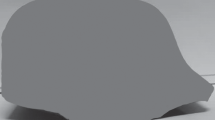Abstract
A layer-by-layer analysis of rails bulk-hardened in oil and differentially hardened in a variety of regimes is performed by means of transmission electron microscopy. Quantitative parameters of dislocation substructures and internal stress fields, and their dependences on the distance from the tread contact surface are established. It is shown that the most dangerous stress concentrators are interfaces between globular cementite matrix particles; such interfaces form predominantly in rails subjected to bulk quenching.
Similar content being viewed by others
References
Gromov, V.E., Berdyshev, V.A., Kozlov, E.V., et al., Gradientnye strukturno-fazovye sostoyaniya v rel’sovoi stali (Gradient Phase-Structure States of Railway Steels), Novokuznetsk: Nedra Communications LTD, 2000.
Gromov, V.E., Kulagin, N.M., Kulakov, S.M., et al., Aktual’nye problemy proizvodstva rel’sov (Topical Problems of Rails Manufacturing), Novokuznetsk: Siberian State Industrial Univ., 2001.
Kozyrev, N.A., Pavlov, V.V., Godik, L.A., and Dement’ev, V.P., Zheleznodorozhnye rel’sy iz elektrostali (Rails Made of Electric Steel), Novokuznetsk: Siberian State Industrial Univ., 2006.
Vorozhishchev, V.I., Sostav i tekhnologiya proizvodstva rel’sov povyshennoi rabotosposobnosti (Composition and Technology for Producing Rails of Increased Workability), Novokuznetsk: Izd. Novokuznetsk. Poligrafich. Kombinat, 2008.
Olivares, R.O., Garcia, C.I., DeArdo, A., et al., Wear, 2011, no. 271, pp. 364–373.
Kang Hao, Wu Di, and Zhao Xian-Ming, J. Iron Steel Res. Int., 2013, no. 20(2), pp. 33–37.
Gromov, V.E., Volkov, K.V., Ivanov, Yu.F., et al., Probl. Chern. Metallurg. Materialoved., 2013, no. 4, pp. 61–68.
Volkov, K.V., Gromov, V.E., Ivanov, Yu.F., and Grishunin, V.A., Povyshenie ustalostnoi vynoslivosti rel’sovoi stali elektronno-puchkovoi obrabotkoi (The Way to Raise Rails Steel Fatigue Endurance by Means of Electron-Beam Processing), Novokuznetsk: Inter-Kuzbass, 2013.
Gromov, V.E., Ivanov, Yu.F., Grishunin, V.A., et al., Usp. Fiz. Metallov, 2013, no. 1, pp. 67–80.
Utevskii, L.M., Difraktsionnaya elektronnaya mikroskopiya v metallovedenii (Diffraction Electron Microscopy in Metal Science), Moscow: Metallurgiya, 1973.
Andrew, K.W., Dyson, D.J., and Keown, S.R., Interpretation of Electron Diffraction Patterns, New York: Plenum Press, 1971.
Hirsch, P., Howie, A., Nicholson, R.B., Pashley, D.W., and Whelan, M.J., Electron Microscopy of Thin Crystals, Huntington: Krieger, 1977.
Panin, V.E., Likhachev, V.A., and Grinyaev, Yu.V., Strukturnye urovni deformatsii tverdykh tel (Structure Levels of Solids Deformation), Novosibirsk: Nauka, 1985.
Rybin, V.V., Bol’shie plasticheskie deformatsii i razrushenie metallov (Great Plastic Deformations and Metals Fracture), Moscow: Metallurgiya, 1986.
Eshelby, J.D., Kontinual’naya teoriya dislokatsii (The Continuum Theory of Dislocation), Moscow: Inostr. Lit., 1963.
Finkel’, V.M., Fizicheskie osnovy tormozheniya razrusheniya (Physical Foundations of Fracture Deceleration), Moscow: Metallurgiya, 1977.
Koneva, N.A. and Kozlov, E.V., Izv. Vyssh. Uchebn. Zaved., Fiz., 1982, no. 8, pp. 3–14.
Vladimirov, V.I., Fizicheskaya teoriya prochnosti i plastichnosti. Tochechnye defekty. Uprochnenie i vozvrat (Physical Theory for Strength and Plasticity. Point Defects. Strengthening and Return), Leningrad: Leningrad Polytechnic Inst., 1975.
Shtremel’, M.A., Prochnost’ splavov (Alloys Strength), part 1: Defekty reshetki (Lattice Defects), Moscow: National Univ. of Science and Technology “MISIS”, 1999.
Koneva, N.A., Kozlov, E.V., Trishkina, L.I., and Lychagin, D.V., Novye metody v fizike i mekhanike deformiruemogo tverdogo tela. Sb. trudov mezhdunarodnoi konf. (Proc. Int. Conf. New Methods in Deformed Solid Physics and Mechanics), Tomsk: Tomsk State Univ., 1990, pp. 83–93.
Gromov, V.E., Kozlov, E.V., Bazaikin, V.I., Ivanov, Yu.F., et al., Fizika i mekhanika volocheniya i ob”emnoi shtampovki (Physics and Mechanics of Drawing and Bulk Stamping), Moscow: Nedra, 1997.
Ivanov, Yu.F., Kornet, E.V., Kozlov, E.V., and Gromov, V.E., Zakalennaya konstruktsionnaya stal’: struktura i mekhanizmy uprochneniya (Hardened Structure Steel: Structure and Ways for Strengthening), Novokuznetsk: Siberian State Industrial Univ., 2010.
Ivanov, Yu.F., Tsellermaer, V.V., Ignatenko, L.N., Popova, N.A., Gromov, V.E., and Kozlov, E.V., Materialovedenie, 2001, no. 1, pp. 40–44.
Author information
Authors and Affiliations
Corresponding author
Additional information
Original Russian Text © V.E. Gromov, K.V. Volkov, A.M. Glezer, Yu.F. Ivanov, K.V. Morozov, K.V. Alsaraeva, S.V. Konovalov, 2014, published in Izvestiya Rossiiskoi Akademii Nauk. Seriya Fizicheskaya, 2014, Vol. 78, No. 10, pp. 1230–1237.
About this article
Cite this article
Gromov, V.E., Volkov, K.V., Glezer, A.M. et al. Dislocation substructures and internal stress fields in bulk- and differentially quenched rails. Bull. Russ. Acad. Sci. Phys. 78, 981–987 (2014). https://doi.org/10.3103/S1062873814100086
Published:
Issue Date:
DOI: https://doi.org/10.3103/S1062873814100086



